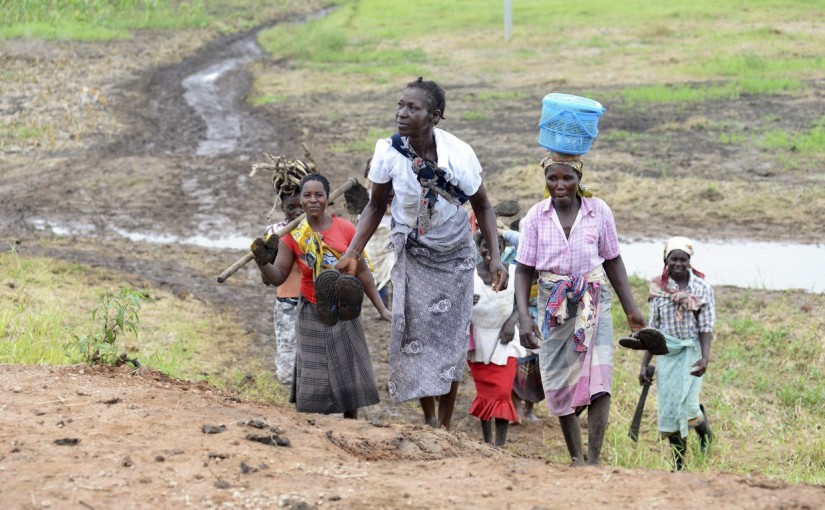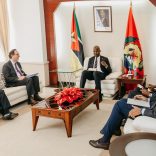Private force of 1,500 to protect Mozambican judges, public prosecutors - Notícias report
“I went to sleep hungry in this land almost all of my childhood, but I can not watch my children suffer: It kills me”

Lusa
In Guijá in southern Mozambique, “things are still complicated”, and after months of severe drought, flooding is now the problem, with the rising Limpopo River affecting hundreds of farmers and menacing the forthcoming growing season.
A little over four kilometers from Caniçada, Guijá district, Rosita Muchanga, a 43-year-old small farmer, assesses the impact of the floods in her machamba, a plot of about 50 square meters on one of the banks of the Nkolawane River, a tributary of the Limpopo.
Rosita explains to Lusa that she has lost almost everything with the rise of the river and today, threatened by what she calls the “constant enemy” of the more than 92,000 people of this small forgotten district in Gaza, she fears for her six children’s future, because, since “Papa Marcos [her late husband] died”, the field had been the mainstay of her family’s survival.
The pools of water in the sprawling fields on the banks of the Nkolawane are testament to the frustration of those who, like Rosita, believed the new year would usher in “better days”, and now, between the mud and wet sand, reaps what little is left to avoid an “old and well-known enemy” in the lands of Gaza: hunger.
“I have no problem; I went to sleep hungry in this land almost all of my childhood. But I can not watch my children suffer. It kills me,” she confesses as she cleans her muddy hoe. “It’s like a curse: when the nightmare is not the drought, it’s the that water takes everything.”
By the end of last year, Guijá, bordered on the southwest by the second largest river in Southern Africa, was struggling with a severe drought that left some 13,000 families in food insecurity after ruining two agricultural campaigns, to the horror of a population dependent on subsistence agriculture.
With the little rain that fell in late February after almost two years of hopelessness, farmers in arid Guijá planted crops such as corn and tomatoes, whose production, in addition to domestic consumption, use to supply neighbouring districts as well as the Mozambican capital.
But with heavy rains in South Africa and Zimbabwe, the Limpopo rose and flooded a significant part of the agricultural land, mostly located in the river plain, the better to take advantage of the waters that cross the province on their way to the Indian Ocean.
“It is a paradox and a cyclical problem. We thought times would improve with the rain, but that did not happen,” says director of economic activities in Guijá, Acácio João. More than 900 hectares have been given as lost in this first phase alone, he says, and, according to information from the National Institute of Disaster Management, “things will get worse”.
Although the Limpopo problem is “not new”, having beset the administrative post of Caniçada in 2013 and neighbouring Chokwé, so far nothing has not been done to avoid the recurrence of the situation, which requires “serious and intentional intervention”.
For the director of the district’s economic activities, building water management infrastructure in the Mapai region, 400 kilometres from the Caniçada administrative post, would facilitate water control and ensure that farmers were able to use the resource well.
But the dream seems distant, judging by the basic challenges that the district still faces, such as the construction of roads and a bridge over the Nkolawane river and the improvement of the health and education systems.
“It would be a divine blessing to have infrastructure like that. We know it is not easy, but it would be a relief for our population,” says Reginaldo Matavel, head of the Chivoguene administrative post, one of the worst affected with more than 87 hectares of various crops lost.
Matavel says the alternative has been to encourage people to sell their livestock to ensure that there is food, a process he says is complicated, in that most of the people had already lost their livestock to the drought.
“Things are not easy,” said the head of the village of Chivoguene, adding that only the help of partners and the National Institute of Disaster Management had in many cases ensured that the district government were able to assist farmers in times of disaster.
“Only a miracle will finally solve this situation. It’s not possible for people to live like this any more,” Matavel says.
But, pending the miracle, the widow Rosita, like the more than 600 farmers who have lost their crops, are tired of “all this poverty” and, once again assailed by the “curse” of Guijá, thinks of leaving everything and going to the capital. “I am tired of looking at my children with nothing, and the question that never leave me is: what have we done to deserve this hunger?” she asks.













Leave a Reply
Be the First to Comment!
You must be logged in to post a comment.
You must be logged in to post a comment.